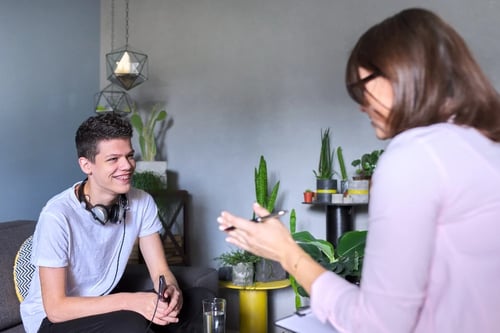Hidden Signs of Self-Harming
Discovering self-inflicted injuries in a teen understandably alarms parents. But most youth engaging in self-harm go to great lengths to conceal wounds and scars. Being attuned to subtle physical and emotional hints can help caring adults recognize when teens may be secretly hurting themselves.

Table Of Content
- Defining Self-Harm
- Subtle Physical Indicators
- Emotional and Behavioral Changes
- Methods Teens Use to Hide Self-Harm
- Well-Intentioned Deception
Self-harm often signals coping with deeper psychological distress that teens struggle voicing directly. Remaining gentle yet vigilant helps guide them to safer ways of expressing inner anguish. In this piece, we will explore overlooked signs of self-harm and methods teens use to hide it so parents can compassionately intervene early. With support, their pain does not have to define their futures.
Defining Self-Harm
Self-harm refers to intentionally injuring oneself without suicidal intent. Cutting remains most prevalent, but self-harm can appear as:
-
Cutting skin with razors, knives, scissors, sharp objects
-
Severe scratching, sometimes using sharp implements
-
Burning with candles, cigarettes, matches, chemicals
-
Punching walls, objects, or oneself
-
Head banging against walls
-
Pulling out hair or eyelashes
-
Restrictive eating disorders
-
Reckless behaviors like substance abuse
While boys engage in self-harm nearly as often as girls, they tend to cut less deeply and hide injuries more successfully due to societal stigma. All genders attempt to hide signs of self-harm.
Subtle Physical Indicators
Subtle Physical Indicators
Look for these possible evidence of self-harm:
-
Frequent bruises, scars, cuts, cigarette burns, or other wounds on the arms, legs, torso—common places easily hidden.
-
Keeping limbs constantly covered by long sleeves and pants even in warm weather
-
Signs of wound care like bandages, gauze, disinfectant, butterflies, or medical tape
-
Blood stains on clothing, towels, or bedding; stains may be concealed as painting projects
-
Unexplained objects like razor blades or pencil sharpener blades missing or found in their space
-
Heightened interest in harm-related media like books/films showing self-injury
The location and repetitive nature of minor injuries should raise suspicion. Let teens know you care about their well-being and want to understand what is causing any wounds.
Emotional and Behavioral Changes
Emotional and Behavioral Changes
Evidence of self-harm may also manifest subtly through:
-
Outbursts of anger or crying more easily
-
Withdrawing from friends and family suddenly
-
Lacking interest in previously enjoyed activities
-
Dropping grades and school disengagement
-
Low self-esteem and harsh self-criticism
-
Refusal to participate in events requiring less skin coverage like swimming parties or dance classes
Personality shifts like increased isolation, secrecy, or lashing out often stem from inner turmoil. Gently ask about what they may be struggling with.
Methods Teens Use to Hide Self-Harm
Methods Teens Use to Hide Self-Harm
To conceal injuries from concerned adults, adolescents engage in elaborate secrecy measures:
-
Cutting in easily hidden places like upper inner thighs or torso
-
Carrying sharp objects like pencil sharpeners to cut in private locations like school bathrooms
-
Wearing bandages, wristbands, belts, or other jewelry to obscure healing wounds
-
Claiming cat scratches or clumsy injuries caused any observed cuts or bruises
-
Attributing scars to past physical injuries to avoid discussing present urges
-
Keeping bedrooms locked and refusing to change with others present
-
Using black ink pens to disguise scabbed-over cuts on arms and wrists
-
Applying makeup like theater blood to create fake wounds, deterring real ones
-
Pretending to stop after intervention, then hiding it better
-
Explaining cuts as an extreme art project or dramatic makeup work
-
Wearing styles with full coverage like hoodies or fishing waders even in hot weather
-
Saving disinfected tools like eraser ends for cutting without detection
-
Storing sharp objects in discreet locations like inside deodorant sticks
-
Flushing blood evidence down toilets
-
Stacked wrist bands, tied T-shirt sleeves, fingerless gloves, or arm warmers worn intentionally for concealment
-
Claiming animal scratches from pets to justify wounds
Teens determined to keep harming secretly get creative covering their tracks. But look past excuses to determine true well-being.
Well-Intentioned Deception
Well-Intentioned Deception
Although secretive, most youth who self-injure do want help stopping. They know the behavior is unhealthy long-term, but shame, fear of punishment, and the instant relief cutting provides leads to hiding it at all costs.
With patience and expressed care, you can work toward a relationship where they feel safe revealing past deception and asking for support resisting future urges. Their life stories don’t have to be defined by secrecy and pain.
Have candid talks about seeking counseling to build healthy coping skills. Make it clear you are on their side fighting the inner demons compelling them to hurt their precious selves. With unconditional love and treatment focused on the roots fueling their self-harm, their light can shine bright.
Healing happens in the light, but self-injury thrives in the darkness of isolation and disbelief things can improve. Compassionate understanding opens the door. Though spotting secretive harm remains challenging, awareness equips parents to delicately intervene, providing the listening ear and treatment access teens need to redirect pain into purpose.
Silence and shame might obscure the signs, but always watch for what your teen’s struggles may be trying to say. Their future still holds joyful possibility. With support, empathy, and care, the days ahead are filled with light.
Let Idaho Youth Ranch help your teen
Teen Counseling
Our masters-educated and trained therapists and counselors have the experience your young person needs to find healing.
Family Counseling
Idaho Youth Ranch can help your family reconnect, open up lines of communication, and build more positive relationships.
Group Counseling
Group therapy helps young people, ages 9 to 24, to address trauma, dangerous behaviors, troubling feelings or experiences.
Equine Therapy
Working with horses has been a proven method of emotional recovery and one of the unique services offered by Idaho Youth Ranch.


.webp?width=500&height=334&name=Idaho%20Youth%20Ranch%20Family%20Counseling%20(1).webp)

